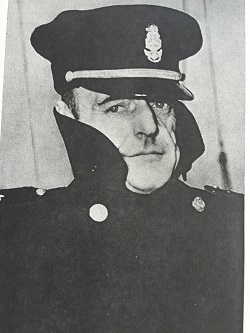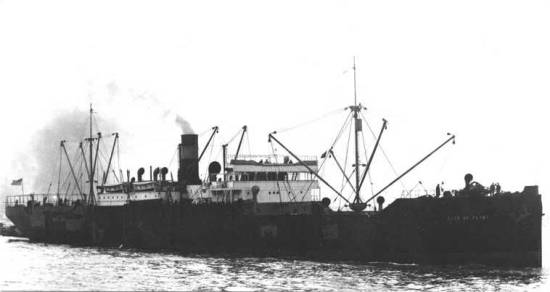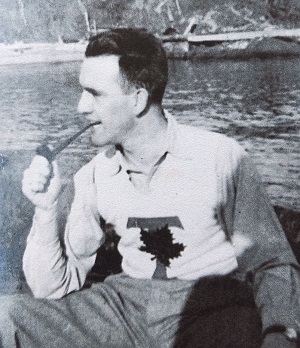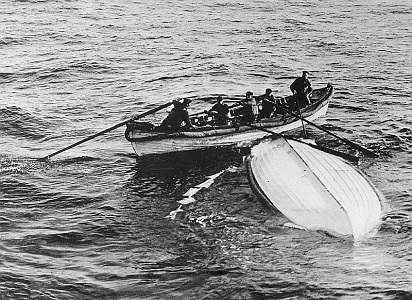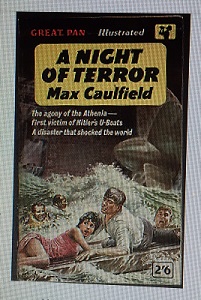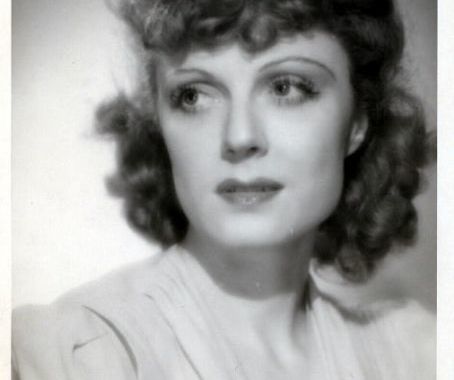The American freighter City of Flint was less than a day into its voyage from Scotland to New York Harbor on Sunday, Sept. 3, 1939, when a radio message relayed news that England and Germany were at war. The ship’s captain, Joseph Gainard, did not expect City of Flint to be a target of hostilities because America had declared its neutrality. But the state of war injected an element of uncertainty into an already stressful Atlantic crossing (see blog post City of Flint Odyssey, Part 1, Sept. 15, 2015).
Read More
SS Athenia
War History City of Flint Odyssey, Part 1
With the threat of war hanging over Europe at the end of August 1939, passenger space on ships leaving England for North America was in great demand. For one ship in particular, the U.S. freighter City of Flint, that demand would unexpectedly swell its passenger manifest from zero to more than 250 in a most unexpected fashion.
When City of Flint’s captain, a crusty New Englander named Joseph Gainard, brought his ship into Glasgow, Scotland, on Aug. 31, he was told by the ship’s agents ashore that the U.S. Maritime Commission in London wanted to talk to him. Unable to get through to the commission, Gainard phoned the U.S. Ambassador, Joseph P. Kennedy, who had once helped him resolve a difficult situation with a crew on another ship when Kennedy was chairman of the Maritime Commission. Read More
Meet the Character David Jennings: Adventures of A Young Man, Part 4
The survivors of the German submarine attack on the British passenger ship Athenia returned to the British Isles, Canada, and the United States to heroes’ welcomes in the waning days of summer 1939. But the headlines quickly faded, superseded by news of German conquests on the Continent, the British Army’s retreat from Dunkirk, and the London blitz.
Athenia survivor David Jennings returned home to begin his senior year at the University of Toronto, albeit a few days later than planned. (See blog post: Adventures of A Young Man, Part 3, Aug. 16, 2015.) While Canadians answered the call of their government to serve as soldiers, sailors and airmen, Jennings completed his engineering degree and in the summer of 1940 and went to work at a local de Havilland Aircraft Company plant. Read More
Meet the Character David Jennings: Adventures of A Young Man, Part 3
The Norwegian freighter Knute Nelson was the first ship to respond to distress signals from the British passenger liner Athenia after she was torpedoed in the North Atlantic on the first day of World War 2. David Jennings, a University of Toronto senior, and his friend and fellow student, Tony Cassels, watched from one of the 26 lifeboats arrayed around the sinking ship as the freighter approached shortly after midnight, came to a stop and began rescue operations.
Working at their oars for nearly two hours, Jennings and Cassels helped bring their boat alongside the big Norwegian ship. As he waited to climb aboard the Nelson, Jennings heard a shout from the deck above and was surprised to see his friend and fellow student John Woods, who had been separated from Jennings and Cassels a few hours earlier. Read More
Meet the Character David Jennings: Adventures of A Young Man, Part 2
The longest continuous military conflict of World War 2 – The Battle of the Atlantic –began at 7:39 p.m., Sunday, Sept. 3, 1939, when a German torpedo loaded with 600 pounds of high explosives slammed into the port side of the British passenger ship Athenia.
At that precise moment onboard Athenia, David Jennings was preparing to leave his Third class cabin near the ship’s bow to attend the third seating for dinner. A University of Toronto student returning home for his senior year, Jennings was accompanied by two university friends, Tony Cassels and John Woods, with whom he had vacationed in the British Isles the previous month. (See blog post July 16, 2015: “David Jennings: Adventures of A Young Man.”) Read More
Meet the Character Rhoda Thomas: Resourceful Grandmother, Part 4
Rhoda Thomas and her fellow Athenia passengers had nearly given up hope of being rescued from their lifeboat when a bright light found them in the early morning darkness of Monday, Sept. 4, 1939. They had been drifting in the North Atlantic for hours following the attack on Athenia by a German submarine (see blog post June 1, 2015).
The light belonged to the luxury yacht Southern Cross, the second rescue ship to reach the scene of the attack. When the yacht came alongside Rhoda’s lifeboat, sailors threw lines to the passengers and pulled them up out of the boat one by one. Read More
Meet the Character Rhoda Thomas: Resourceful Grandmother, Part 1
The threat of war was not a major consideration for my grandmother, Rhoda Thomas, when she visited relatives and friends in her native England during the summer of 1939. Although German Chancellor Adolf Hitler was making territorial demands on Poland, few people thought the situation would lead to war.
Born in 1885, Rhoda had grown up in the little town of Street near Glastonbury in southwest England. She had met and married her husband, Frank Thomas, in Street and the couple had a son and a daughter before immigrating to the United States in 1914. Two more children were born in the U.S., where Rhoda and Frank became naturalized citizens in 1922. In the years that followed, Rhoda devoted herself to her husband, children, and grandchildren, and even in the most difficult days of the Great Depression she never lost her sense of humor or her trust in God,.
After her youngest daughter married in 1939, Rhoda left at the end of July for a two-month visit to Street. If she felt any hesitation boarding the ship in New York Harbor, it was because Frank, who worked for the State of New York Employment Office, could not accompany her. Read More
Judith Evelyn: An Act of Survival, Part 3
In the early morning hours of Monday, Sept. 4, 1939, Judith Evelyn found herself adrift in the Atlantic Ocean on the overturned bow section of her wrecked lifeboat. The burgeoning stage actress had been returning to Canada when her ship, the British liner Athenia, was torpedoed by a German submarine only hours after England and Germany declared war (see blog post March 15, 2015, Judith Evelyn, Part 2).
Evelyn escaped the sinking ship along with her former fiancé, Andrew Allan, and his father, the Reverend William Allan. After several hours in the lifeboat, they were in the process of being rescued when the propeller of the would-be rescue ship inadvertently chopped their boat to pieces, tossing all aboard into the sea. Read More
Meet the Character Judith Evelyn: An Act of Survival, Part 2
In the early afternoon of Sunday, Sept. 3, 1939, Judith Evelyn experienced a grim premonition. A Canadian stage actress, Evelyn was returning home aboard the British passenger liner Athenia. She had just learned that England and Germany declared war, and when she saw Athenia’s crewmen provisioning the ship’s lifeboats, the thought came to her that, “We shan’t be out of this without being the lifeboats.”
Evelyn had made a last-minute decision to join her fiancé, Andrew Allan, and his father, William Allan, a Presbyterian minister, on the voyage home after she and Andrew had spent more than a year pursuing their careers in London (see blog post March 1, 2015, Judith Evelyn, Part 1). Read More
Judith Evelyn: An Act of Survival, Part 1
Judith Evelyn, a 30-year-old Canadian stage actress, boarded the British passenger liner Athenia with a sense of foreboding the morning of Sept. 1, 1939, in Glasgow, Scotland. That same morning the German army invaded Poland, and England launched a nationwide emergency evacuation of schoolchildren from cities likely to become targets if Britain went to war.
The circumstances appeared bleak for this bright and ambitious actress from Canada’s Prairie Provinces who had pushed her career from humble beginnings to unexpected heights.
Judith Evelyn was born Evelyn Morris in Seneca, South Dakota, but grew up in Winnipeg, Canada, with a step-father who was a successful stage actor. Young Evelyn fell in love with acting, working with her step-father in the Chautauqua shows of rural Manitoba and Saskatchewan. When she changed her name from Evelyn Morris to Judith Evelyn there was no doubt she intended to make acting a career. Read More


